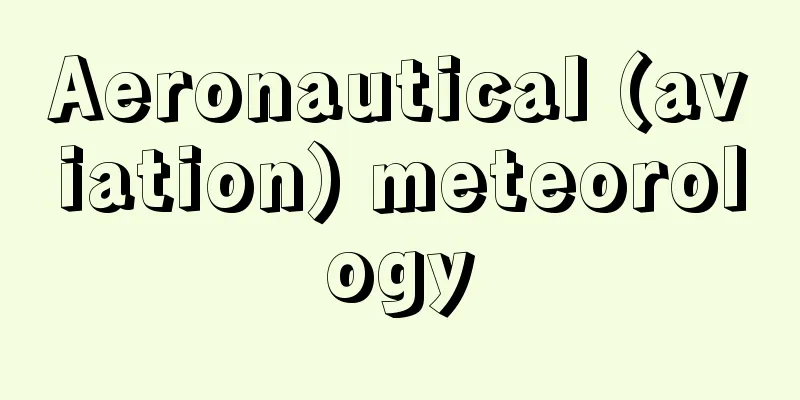Aeronautical (aviation) meteorology

|
The science or meteorological work that deals with meteorological phenomena necessary for aircraft operation. The purpose of aviation meteorology is to use weather information to operate aircraft safely, economically, and on schedule. For example, in the case of long-distance flights, the relationship with operation is as follows: (1) Pre-flight planning: Prior to a flight, the best course is determined using numerical forecasts of wind, temperature, and significant weather (weather phenomena that can disrupt flight, such as active thunderstorms, severe turbulence, heavy icing, etc.) within the flight area, and a flight plan is created using forecasts for local airports to determine whether departure and landing can be completed as scheduled. (2) Takeoff Once the plan is complete, loading operations begin, but since takeoff weight depends on wind, temperature, and runway conditions, the amount of loading is determined from the takeoff forecast and checked against observed values before taking off. Immediately after takeoff, there is not enough lift, so strong downdrafts that suddenly reduce lift, a sudden decrease in headwind components (a sudden increase in tailwind components), and a sudden rise in temperature (inversion layer) are important factors along with visibility, crosswinds, and bad weather. (3) Cruise Jet planes fly at high altitudes, so they are less affected by bad weather, but clear air turbulence (CAT) and high altitude mountain waves remain a nuisance. This is because they occur in a narrow area and have a short life span, so they cannot be directly forecast and there are no instruments to detect them. Aircraft flying at low altitudes also encounter various bad weather conditions, but those caused by thunderclouds can be avoided by on-board radar. (4) Preparation for landing Because fuel consumption is greater at low altitudes than at high altitudes, if there is no prospect of landing, it is safer and more economical to fly directly to an alternative airport. Therefore, when the flight distance to the destination airport is about one hour, the captain decides which airport to land at. To help with this decision, major international airports around the world (such as Narita Airport in Japan) broadcast short-term airport forecasts for whether landing is possible along with observational values to aircraft. This is called a Bolmet broadcast. (5) Approach During approach for landing, thunderclouds of the same strength have a greater effect than during cruising. In particular, sudden changes in wind and vertical currents associated with thunderclouds, called wind shear, are important, and information from radar echoes alone is insufficient, so Doppler radars that can also observe wind are installed at major airports. In addition, there is a lightning monitoring system called the Lightning Detection Network (LIDEN) to prevent lightning strikes on aircraft, but it cannot detect lightning strikes on aircraft. Furthermore, in the final stage of landing, even aircraft flying instruments cannot land if they cannot see the runway when they descend to the altitude at which they switch to visual observation (decision altitude). In this case, the pilot is looking at an angle, so diagonal visibility is required, but since this observation has not been put to practical use, ground observation values are used. In order to land, visibility and minimum cloud height must be above a certain value, and this value is called the minimum weather condition. How much can be seen is measured using a forward scatter meter installed near the touchdown zone of the runway to measure scattering by (fine) particles in the atmosphere, and the result is converted into the runway visual distance. (6) Landing To land, aircraft must slow down while descending using radio signals so that they pass 50 feet (about 15.2 meters) above the end of the runway at 1.3 times the stall speed (reference speed). However, in areas with strong downdrafts or a sudden decrease in headwind (a sudden increase in tailwind), large aircraft experience a sudden decrease in lift, so sudden changes in wind at low altitudes are particularly important. There are also fluctuations due to microbursts, local fronts, topographical influences, downwinds, etc. In addition, there are restrictions on landing when there is a strong crosswind or when the friction coefficient is small on a wet runway. Naturally, forecasts and warnings for airport facilities and parked aircraft are also included in aviation meteorological services. (7) Future Issues Advances in numerical forecasting have greatly improved meteorological information for flight planning, from global to domestic flights, and have contributed greatly to economical flight operations. Meanwhile, improvements in the performance of aircraft and ground support facilities have made weather-related cancellations extremely rare. From another perspective, this means that aircraft fly close to dangerous phenomena. However, these phenomena are small-scale and short-lived, so operations cannot be stopped just because they occur. These phenomena cannot be directly forecast, so detection equipment is required. While there is on-board radar for thunderclouds, no detection equipment has been developed for clear-air turbulence and wind shear, which cannot be seen with the naked eye. Meanwhile, the number of small aircraft is increasing year by year, but these flights are often visually guided and are greatly affected by weather conditions, so in addition to the above, a wide range of meteorological information is required. [Akira Nakayama] "Aviation Meteorology" by Okada Takematsu (1942, Iwanami Shoten)" ▽ "Aviation Meteorology" edited by Sugiura Hiroshi (1954, Hōbunshorin)" ▽ "Applied Meteorology Series 4: Aviation Meteorology" edited by Agematsu Kiyoshi, Yamada Naokatsu, and Utsugi Masao (1960, Chijin Shokan)" ▽ "Aviation Meteorology" by Ito Hiroshi (1971, Tokyodo Publishing)" ▽ "Introduction to Aviation Meteorology" by Ito Hiroshi (1973, Tokyodo Publishing)" ▽ "Aviation Meteorological Dictionary" edited by Ito Hiroshi (1974, Tokyodo Publishing)" ▽ "How to Read Aviation Meteorological Information - Actual and Forecast Reporting Format" edited by Kato Kimio (1995, Seizando Shoten)" ▽ "The Latest Aviation Meteorology - For Nowcasting Bad Weather" by Nakayama Akira (1996, Tokyodo Publishing)" ▽ "Introduction to Aviation Weather: Aviation Weather Edition" by the FAA (United States Department of Transportation), translated and supervised by the Aviation Sports Division of the Japan Aeronautical Association (2000, National Sky Leisure Promotion Council)" ▽ "The ABC of Aviation and Weather, 3rd Edition, by Kato Kimio (2003, Seizando Bookstore)" ▽ "New Aviation Weather, 12th Revised Edition, by Hashimoto Umeji and Suzuki Yoshio (2003, Climb Meteorological Book Publishing Division)" [References] | | | | | | | | | | | | |Source: Shogakukan Encyclopedia Nipponica About Encyclopedia Nipponica Information | Legend |
|
航空機の運航に必要な気象現象を扱う学問、または気象業務。航空気象の目的は、安全に、経済的に、スケジュールどおり運航するように気象情報を利用することで、例を長距離飛行にとると運航とのかかわりは次のとおりである。 (1)飛行前計画 飛行実施に先だち、飛行領域内の風、気温、悪天significant weather(飛行障害となる気象現象で、活発な雷雨、強い乱気流、強い着氷など)の数値予報を用い最良のコースを決め、また、各地の飛行場予報を用いてスケジュールどおりの出発や着陸が可能かどうかを知り飛行計画をたてる。 (2)離陸 計画ができると、積み荷作業を始めるが、離陸重量は風、気温、滑走路状態に左右されるので、離陸時の予報値(離陸予報)から積み荷量を決め、観測値でチェックして離陸する。離陸直後は十分な揚力がないので、揚力を急減させる強い下降気流、向かい風成分の急減(追い風成分の急増)、気温急昇(逆転層)は、視程、横風、悪天とともに重要な要素である。 (3)巡航 ジェット機は高空を飛ぶため、悪天の影響は少なくなったが、晴天乱気流(CAT(キャット))、高高度の山岳波は依然としてやっかいである。理由は、これらは発現する範囲が狭く、寿命も短いので、直接予報できないし探知する機器がないからである。また、低高度を飛ぶ航空機は種々の悪天に遭遇するが、雷雲によるものは機上レーダーで回避できる。 (4)着陸準備 低空では高空に比べ燃料消費が大きいため、着陸できる見込みがなければ、そのまま代替飛行場に直行したほうが安全かつ経済的なので、機長は目的飛行場へ1時間ぐらいの飛行距離になったとき、どの飛行場に着陸するかを決める。この判断材料として世界の主要国際空港(日本では成田)では、着陸できるかどうかの短時間先の飛行場予報を観測値とともに航空機に向け放送している。これをボルメット放送という。 (5)進入 着陸のための進入中は、同じ強さの雷雲でも巡航中よりも大きな影響を受ける。とくに、ウインドシアとよばれる、雷雲に伴う風や鉛直流の急変は重要で、レーダーエコーだけの情報では不十分なので、主要空港には風も観測できるドップラーレーダーが設置されている。また、航空機への落雷防止には雷監視システムLightning Detection Network(LIDEN(ライデン))があるが、航空機への落雷を知ることはできない。さらに着陸の最終段階では、計器飛行を行っている航空機でも目視に切り換える高度(決心高度)まで降下したとき、滑走路が視認できなければ着陸できない。この場合、パイロットは斜めに見ているので斜め視程が必要だが、この観測は実用化されていないため、地上での観測値を用いている。着陸するためには、視程と最低雲高が、ある値以上なければならず、この値を最低気象条件という。どれだけ見えるかは、滑走路の接地帯近くに設置した前方散乱計で大気中の(微)粒子による散乱を測定し、これから、滑走路視距離に換算したものを用いている。 (6)着陸 着陸するには、滑走路の端末50フィート(約15.2メートル)の高さを失速速度の1.3倍(基準速度)で通過するように電波にのって降下しながら減速するが、強い下降気流、向かい風の急減(追い風の急増)があるところでは、大型機は揚力の急減をおこすため、低層での風の急変はとくに重要で、マイクロバーストmicroburstをはじめ、局地的な前線、地形の影響、おろし風などによる変動もある。このほか、強い横風のときや、湿った滑走路で摩擦係数の小さいときには着陸に制限が加わる。また、当然のことだが、飛行場施設や駐留機のための予警報も航空気象業務のなかに含まれる。 (7)今後の課題 数値予報が進歩したことにより、地球規模の大きさから国内飛行まで、飛行計画用の気象情報は大幅に改善され、経済運航に大きく寄与している。一方、航空機や地上援助施設の性能が向上したことにより天候による欠航はきわめて少なくなった。このことは見方を変えれば、航空機は危険な現象と隣り合わせで飛行していることになる。しかしこれらの現象は小規模で寿命も短いため、これがあるからといって運航を中止することはできない。これらの現象は直接予報できないから探知機器が必要である。雷雲については機上レーダーがあるが、目で見ることのできない晴天乱気流やウインドシアは探知機器が開発されていない。一方、小型機も年々増加しているが、これらは目視飛行が多く、気象条件に大きく左右されるので、いままで述べたことに加え、さらに多項目にわたる気象情報が必要となる。 [中山 章] 『岡田武松著『航空気象学』(1942・岩波書店)』▽『杉浦弘編著『航空気象』(1954・鳳文書林)』▽『上松清・山田直勝・宇津木政雄編『応用気象学大系4 航空気象学』(1960・地人書館)』▽『伊藤博著『航空気象』(1971・東京堂出版)』▽『伊藤博著『航空気象入門』(1973・東京堂出版)』▽『伊藤博編『航空気象用語辞典』(1974・東京堂出版)』▽『加藤喜美夫編著『航空気象情報の読み方――実況・予報通報式』(1995・成山堂書店)』▽『中山章著『最新 航空気象――悪天のナウキャストのために』(1996・東京堂出版)』▽『FAA(アメリカ合衆国運輸省)著、日本航空協会航空スポーツ室訳・監修『航空気象入門 航空気象編』(2000・全国スカイレジャー振興協議会)』▽『加藤喜美夫著『航空と気象ABC』3訂版(2003・成山堂書店)』▽『橋本梅治・鈴木義男著『新しい航空気象』改訂12版(2003・クライム気象図書出版部)』 [参照項目] | | | | | | | | | | | | |出典 小学館 日本大百科全書(ニッポニカ)日本大百科全書(ニッポニカ)について 情報 | 凡例 |
>>: Aircraft construction material
Recommend
Fraction formula - fraction formula
Let A and B be rational polynomials (polynomials)...
Mother Earth
…A skilled orator, he contributed to the American...
milk
American gay liberation activist and politician. A...
Eeden, Frederik Willem van
Born: April 3, 1860 in Haarlem [Died] June 16, 193...
Interjection - Kantoujoushi
〘Noun〙 A type of particle in Japanese grammar. For...
Aktaiōn (English spelling) Aktaion
…However, one of the nymphs, Kallistō, was loved ...
Winkelried, A. von (English spelling) Winkelried Avon
...Today, a Landsgemeinde (a direct democratic re...
Scarabaeus
…A group of beetles belonging to the family Scara...
Mount Han (Korea) - Kanzan
...The old city is surrounded by mountains on all...
computer network
A state in which multiple computers are connected ...
Fluidal texture
…When magma flows before and after erupting, it d...
Ometepe [island] - Ometepe
The Tipitapa River flows into the lake from Lake ...
Ahimsa (English spelling) ahiṃsā
Not to kill, not to harm. One of the important ide...
Student Union Incident
This was the first case in which members of the A...
Uke (Ken) - Uke
It is also called "Ue". It is a fishing ...









